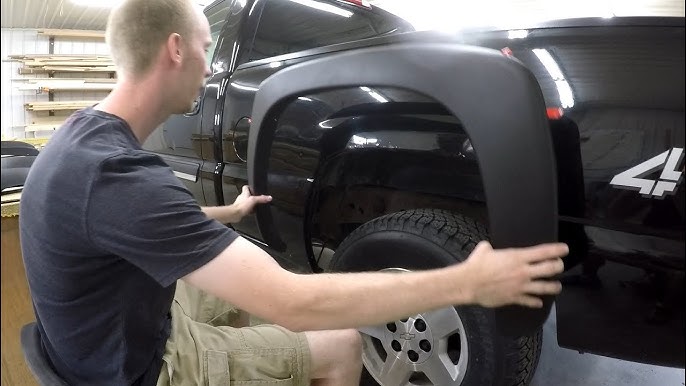Introduction of Fender Flares to Cover Rust
Rust is a silent enemy for vehicle owners, eating away at metal surfaces and compromising both aesthetics and structural integrity. Whether you live in a humid coastal area, endure harsh winters with salted roads, or simply own an aging vehicle, rust can become an inevitable problem.
Many people turn to fender flares to cover rust as a quick and stylish solution. But can fender flares truly fix rust, or are they just a band-aid on a deeper issue? As a fender flare expert, I’m here to give you the full picture—busting myths, revealing hidden drawbacks, and offering practical advice on whether fender flares are the right choice for dealing with rust.

The Role of Fender Flares: More Than Just Aesthetic Accessories
Before diving into whether fender flares can hide rust, it’s important to understand their purpose. Fender flares are aftermarket or factory accessories designed to extend the width of a vehicle’s fenders. They serve multiple purposes, including:
- Providing additional coverage for larger tires, especially for off-road vehicles.
- Protecting the vehicle from mud, debris, and road grime kicked up by the wheels.
- Enhancing the vehicle’s overall appearance with a rugged, aggressive, or custom look.
- Potentially offering some level of protection against minor fender damage.
Given these benefits, it’s easy to see why people assume fender flares can be a practical way to cover rust. But is this assumption accurate? Let’s explore the advantages and disadvantages.
Benefits of Using Fender Flares to Cover Rust
1. Immediate Aesthetic Enhancement
If your vehicle has visible rust spots around the fender area, installing fender flares can instantly improve its appearance. Instead of looking at unsightly corrosion, you’ll have sleek, well-fitted flares that give your car a more polished and aggressive style.
2. Partial Protection Against Further Damage
While fender flares do not eliminate rust, they can act as a temporary shield against direct exposure to rain, snow, and road salt. By covering the affected area, they can slow down further rust development—especially if combined with rust treatment before installation.
3. A Cost-Effective Alternative to Body Repairs
Professional rust repairs can be expensive, often requiring sanding, repainting, or even replacing fender panels. Fender flares, on the other hand, provide an affordable way to mask the issue while postponing costly repairs.
4. Customization and Personalization
Fender flares come in various styles, including bolt-on, pocket-style, and OE-style, allowing vehicle owners to customize their ride while addressing rust concerns. If you’ve ever wanted to give your truck or SUV a more off-road-ready look, fender flares can serve a dual purpose.
Drawbacks of Using Fender Flares to Cover Rust
1. They Do Not Stop Rust from Spreading
One of the biggest misconceptions is that fender flares “fix” rust. The truth is, unless the rust is properly treated before installation, it will continue to spread underneath the flare. Over time, this can lead to more extensive damage, making future repairs even more costly. Actually, you can use a fender cover to avoid the rust easily.
2. Potential Moisture and Dirt Trapping
Fender flares create a gap between the vehicle’s body and the flare itself. If not properly sealed, this gap can trap moisture, dirt, and road salt, accelerating rust rather than preventing it. Many car owners mistakenly believe they are protecting their vehicle, when in reality, they could be making the problem worse.
3. Risk of Improper Installation
If fender flares are not installed correctly—whether using bolts, clips, or adhesive—they can come loose or fail to cover the rust adequately. Poor installation can lead to scratching the vehicle’s paint, exposing more metal to the elements and further encouraging rust formation.
4. They May Not Be Legal in All Areas
Certain states and countries have regulations regarding fender flares, particularly if they extend too far beyond the factory fender. It’s essential to check local laws before installing them, especially if they significantly alter your vehicle’s width.
Key Considerations Before Using Fender Flares to Cover Rust
1. Assess the Extent of the Rust Damage
Before deciding on fender flares, carefully inspect your vehicle to determine the severity of the rust. If the rust is surface-level, you may be able to apply rust inhibitors before installing flares. However, if the rust has already caused structural damage, fender flares will only mask the problem temporarily.
2. Choose High-Quality Fender Flares
Not all fender flares are created equal. Investing in high-quality materials such as ABS plastic or fiberglass can make a difference in durability and longevity. Cheap or poorly made flares may crack, fade, or become loose over time, reducing their effectiveness.
3. Apply Rust Treatment Before Installation
To maximize the longevity of your vehicle, it’s best to treat the rust before installing fender flare. This may involve sanding down the rusted area, applying a rust converter, and sealing it with primer or protective paint.
4. Seek Professional Installation
If you’re unfamiliar with installing fender flare, consider seeking professional help. A skilled mechanic or auto body shop can ensure proper fitment, seal gaps to prevent moisture buildup, and advise on any additional rust prevention steps.
FAQs About Fender Flares to Cover Rust
1. Can fender flare completely hide rust on my vehicle?
Yes, they can visually conceal rust, but they do not stop the rust from spreading underneath. Without proper treatment, the rust will continue to grow, potentially causing structural issues.
2. How long do fender flare typically last before needing replacement?
High-quality fender flare can last several years, especially if made from durable materials like ABS plastic. However, exposure to harsh weather conditions and poor installation can shorten their lifespan.
3. Are there better alternatives to covering up rust besides fender flare?
Yes, alternatives include sanding and repainting the affected area, applying rust converters, or replacing the rusted panel entirely. If rust is extensive, professional repair is the best long-term solution.
4. Can fender flare prevent future rust formation?
They can provide some protection from direct exposure to the elements, but they do not prevent rust. Proper rust treatment and maintenance are still necessary.
Conclusion of Fender Flares to Cover Rust
Fender flares can serve as a temporary aesthetic fix for rust, but they are not a permanent solution. While they enhance the look of a vehicle and offer minor protection, they also carry risks, including moisture trapping and hidden rust progression.
If you are considering using fender flares to cover rust, take the time to assess the damage, choose high-quality flares, and treat the rust before installation. By making an informed decision, you can enjoy both style and durability while preventing costly repairs in the long run.
Ultimately, fender flare is best used for what they were designed for—style and protection against debris—not as a rust repair solution. If rust is a major concern, addressing the root cause will always be the smarter long-term approach. Contact Kairun Auto Parts for more professional information.
